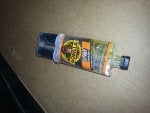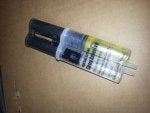Hi all,
I was wondering if anyone could help me out with the following.
I've been looking around for methods to make a zero clearance throat plate.
I've decided on the Instructables one. You can see the method here:
Easy zero clearance throatplate for any table saw
I asked the author to help clarify a few points, I don't know if he still maintains his site, I haven't heard back from him.
These are the points I asked him to make clearer, any help much appreciated.
Thanks.
" Hi,
I'm emailing you about your Instructables Easy zero clearance throatplate for any table saw.
Would be appreciated if you could clarify a couple of points.
Ebay UK I can't buy Loctite Epoxy Gel. I can buy Loctite Super Glue-Power Flex Gel Flexable
adhesive see Ebay UK item number 151760378900. I assume this is much the same stuff and will be OK?
In the UK we don't sell masonite , we do have what we call hardboard. I Googled,
and seems masonite and hardboard are the same thing.
The filler strip, " Cutting the filler thicker lets you sand it perfectly with the plate. "
How do I go about sanding the filler strip perfectly level with the plate?
" You might want to use a glue that you can soften with heat, so you can remove and replace it after it gets old.
I used wood glue. "
I looked up Elmers Carpenters wood glue didn't give any information about being able to soften with heat.
I Googled carpenters wood glues that can be removed with the application of heat.
I found, " white glue is a must-have for interior craft projects. Made with polyvinyl acetate (PVA)
and can be softened with steam or warm water." So would I be OK to glue the filler in place with PVA?
Thanks. "
I was wondering if anyone could help me out with the following.
I've been looking around for methods to make a zero clearance throat plate.
I've decided on the Instructables one. You can see the method here:
Easy zero clearance throatplate for any table saw
I asked the author to help clarify a few points, I don't know if he still maintains his site, I haven't heard back from him.
These are the points I asked him to make clearer, any help much appreciated.
Thanks.
" Hi,
I'm emailing you about your Instructables Easy zero clearance throatplate for any table saw.
Would be appreciated if you could clarify a couple of points.
Ebay UK I can't buy Loctite Epoxy Gel. I can buy Loctite Super Glue-Power Flex Gel Flexable
adhesive see Ebay UK item number 151760378900. I assume this is much the same stuff and will be OK?
In the UK we don't sell masonite , we do have what we call hardboard. I Googled,
and seems masonite and hardboard are the same thing.
The filler strip, " Cutting the filler thicker lets you sand it perfectly with the plate. "
How do I go about sanding the filler strip perfectly level with the plate?
" You might want to use a glue that you can soften with heat, so you can remove and replace it after it gets old.
I used wood glue. "
I looked up Elmers Carpenters wood glue didn't give any information about being able to soften with heat.
I Googled carpenters wood glues that can be removed with the application of heat.
I found, " white glue is a must-have for interior craft projects. Made with polyvinyl acetate (PVA)
and can be softened with steam or warm water." So would I be OK to glue the filler in place with PVA?
Thanks. "











